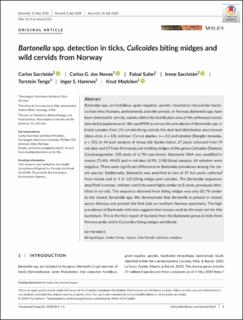| dc.description.abstract | Bartonella spp. are fastidious, Gram‐negative, aerobic, facultative intracellular bacteria that infect humans, domestic and wild animals. In Norway, Bartonella spp. have been detected in cervids, mainly within the distribution area of the arthropod vector deer ked (Lipoptena cervi ). We used PCR to survey the prevalence of Bartonella spp. in blood samples from 141 cervids living outside the deer ked distribution area (moose [Alces alces , n = 65], red deer [Cervus elaphus , n = 41], and reindeer [Rangifer tarandus , n = 35]), in 44 pool samples of sheep tick (Ixodes ricinus , 27 pools collected from 74 red deer and 17 from 45 moose) and in biting midges of the genus Culicoides (Diptera: Ceratopogonidae, 120 pools of 6710 specimens). Bartonella DNA was amplified in moose (75.4 %, 49/65) and in red deer (4.9 %, 2/41) blood samples. All reindeer were negative. There were significant differences in Bartonella prevalence among the cervid species. Additionally, Bartonella was amplified in two of 17 tick pools collected from moose and in 3 of 120 biting midge pool samples. The Bartonella sequences amplified in moose, red deer and ticks were highly similar to B. bovis , previously identified in cervids. The sequence obtained from biting midges was only 81.7 % similar to the closest Bartonella spp. We demonstrate that Bartonella is present in moose across Norway and present the first data on northern Norway specimens. The high prevalence of Bartonella infection suggests that moose could be the reservoir for this bacterium. This is the first report of bacteria from the Bartonella genus in ticks from Fennoscandia, and in Culicoides biting midges worldwide. | en_US |

